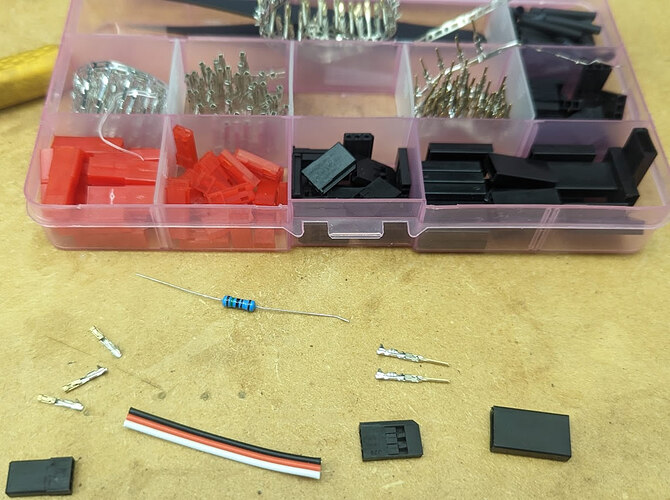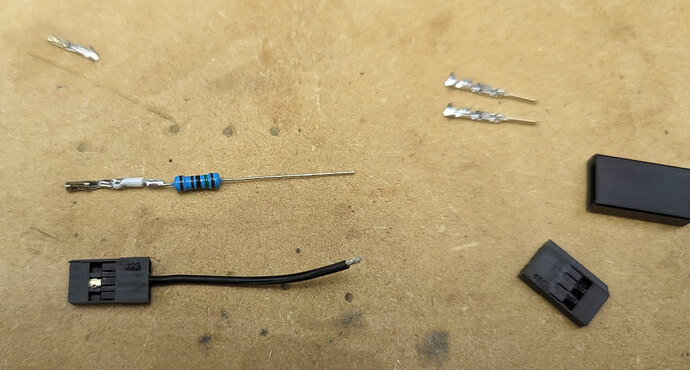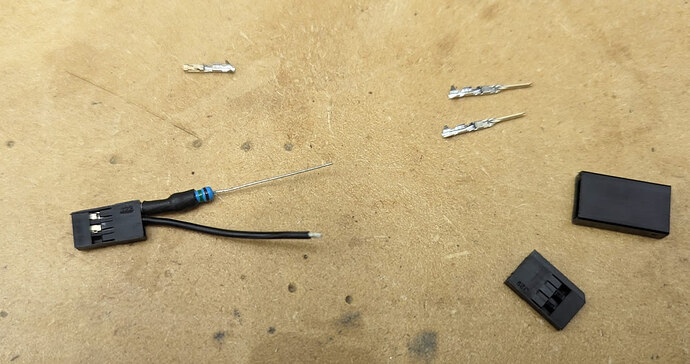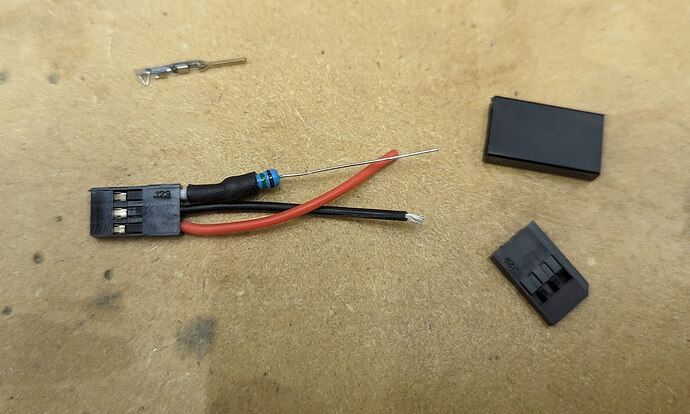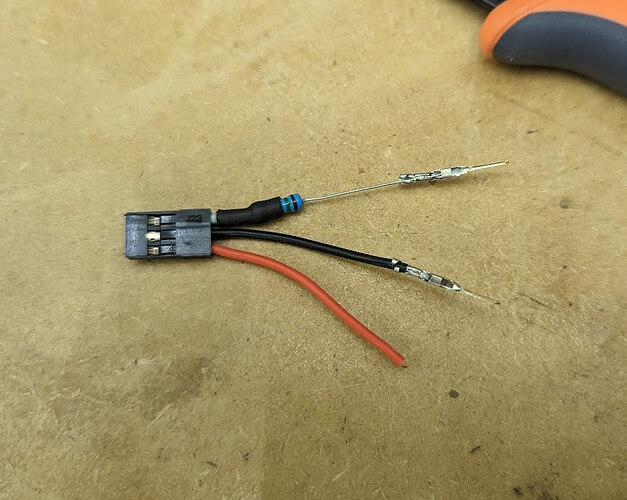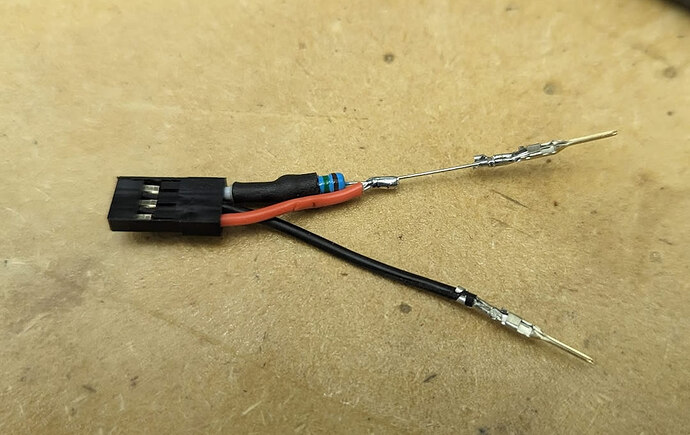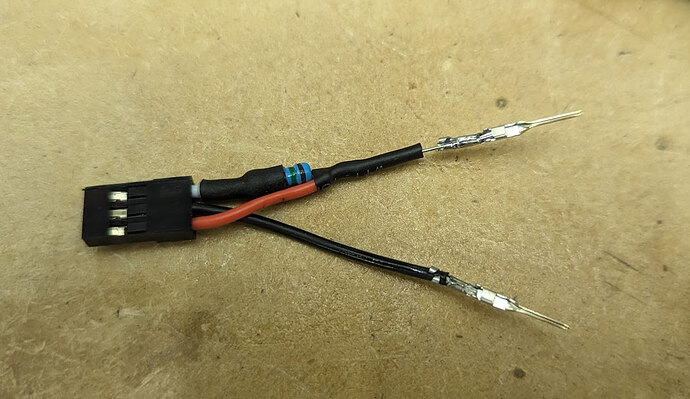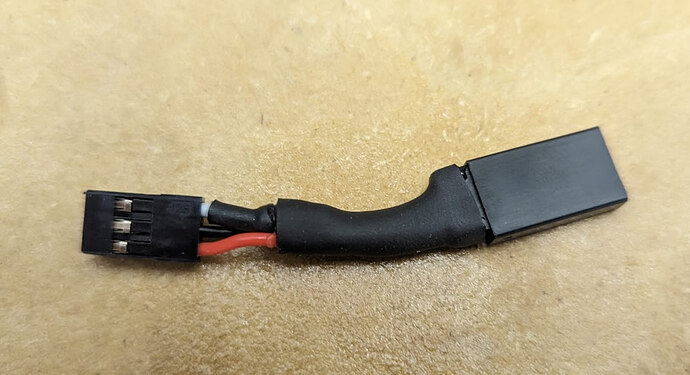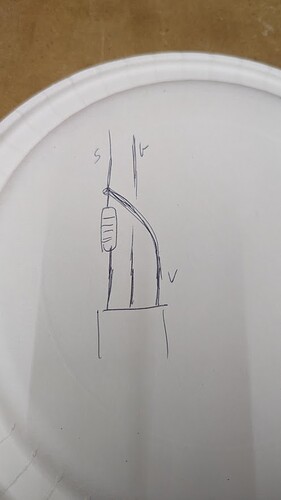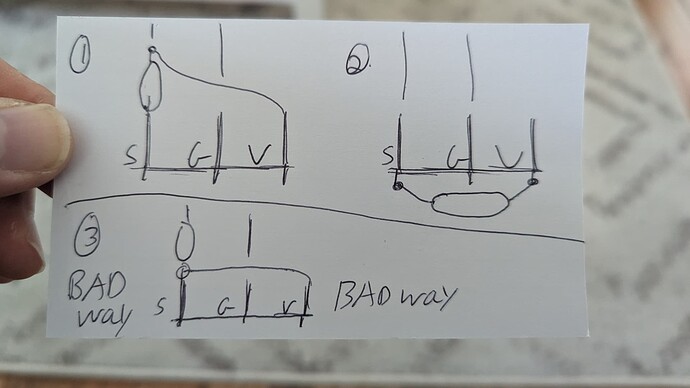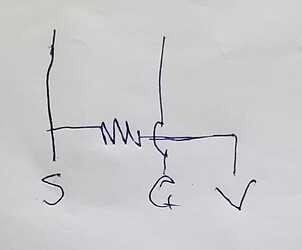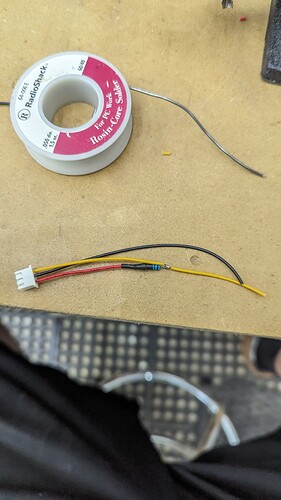@MakerJim excellent idea
Yes, this will work with a resistor between the red connection and the white wire.
what wattage resistor? they make 1.5k in 1/4 all the way up to 2 watts.
Sorry I missed these questions earlier. You will be pulling very little current through the resistor. Even 1/8 watt resistor will be fine. With a 1.5K ohm resistor, you will be pulling less than 2 ma.
does it matter which way the resistor faces?
No.
waiting on resistors to show up via amazon then will post response if it worked
i also emailed BIGTREE to test how well their support is i.e. if they will mail me a new board.
See below for solution
Super happy that the pigtail correction fixed the issue.
We should make a good guide for how to make this pigtail as it surely would help others.
Below are photos of how to make a pigtail to solve the pullup problem without soldering to your board or do anything overly complex.
Items required:
1.5k resistors
HiTec Servo Terminal Kit
Crimp Tool
Heat Shrink Tube
Process in photos:
I make the smallest little white wire possible so it can go into the connector and also be flexible so it can fold over in your case. I then solder the resistor wire (shortened of course) to the white wire.
The crimp to the resistor wire was strong, however, i added a dab of solder as reassurance and for a solid connection.
I use heat shrink tube that already has hot melt glue on the inside. It is the best kind IMO unless you need things to remain flexible.
I’m working on a setup/board exhibiting this limit switch issue. Switches are reading near 2.03 typically. I made some pig tails with 1K resistors and switches are now reading 2.65 with some homing activities improving, but not 100% correct.
Question → Should I make connections with 2K resistors which I have on hand, or wait and order 1.5k resistors? Is there a significant risk going with 2K vs 1.5K? Thanks all!
If you are reading 2.65V, then any issues you are seeing are not related to the SKR Pro board issue. I suggest you open a new topic with your problems. The underlying issue with the SKR Pro board is Marlin not reading the pin as HIGH. A voltage of 2.65V is well above the threshold where Marlin should see the pin as HIGH. You will never get a full 3.3V at the pins unless you disconnect the LEDs.
As for the resistor, 2K will result in less voltage rise, so it will be less likely to fix the problem, so there is no benefit to going with a 2K resistor. A 1.5K resistor also has less benefit (in terms of increasing the pin voltage when HIGH) than a 1K resistor.
I just took a close look at pictures of the adapters you constructed (when answering another question), and I believe they are wired incorrectly. The V voltage needs to flow through the resistor before it is connected to the signal pin. If I’m analyzing this correctly, you have the V flowing to the signal (out) pin directly, and the resistor in line with S. What confuses me is that I believe your endstops worked correctly after you installed these adapters. With NC switches, I would expect the board to not function with a risk of burning out pins or blowing the 5V voltage regulator.
This might explain the issues you were expressed in your Z homing consistency topic and the board failing after you tried to add a resistor to the Z min endstop. The SKR Pro board is pretty robust. If you remove the adapter, does the old board still fail?
@robertbu hey there. thanks for double checking. i think the wiring is good though. how do i know, i wired it wrong once. this is the correct way. with the V coming in FRONT of resistor before feeding back into the signal side. think about it a reverse way. soldering the two together on the back of the board you are going V through resistor to S.
the setup did completely fix my issue on the switches i had issues. i never had a pullup resistor on my z stop. that acted up bc of loose wiring on the tiny touch plate side of the connection. i put a new crimp connector on it and crimped the hell out of it. i also put pullups on ALL my end stops wired like the below and this new board w/ the pullup wiring works perfectly.
Your wiring diagram is incorrect to solve the problem. The resistor should be inline with the curve V line, not inline with the S line. In fact, I don’t understand 1) why it worked, and 2) why it did not, at least, shut down your board. When the endstop is closed, this circuit shorts V to G. Boards with protection can survive this problem, but it can burn out the pin or blow the voltage regulator. You may have been saved by the LED in the circuit.
I dunno. look at the path of current. in pic 2 v goes to s and back feeds s. all be it with the resisted voltage. pic 1 back feeds the s pin with resisted voltage and the 5v micro switch with 5v. either way the board pin s is getting resisted voltage. the micro switch can handle the 5v. nothing is fried and everything works.
if you wired it like 3 then you created a problem.
The resistor goes between the V pin and the S pin. Your pic 2 is the correct way to wire it. Rewriting your pic 1 the way it should be wired gives:
Note this matches both your pic 2 and the wiring when the resistor is soldered directly to the board.
In terms of functionality, you have to evaluate this added resistor in terms of the internal circuitry. You are placing another resistor in parallel with the one on the circuit board, reducing the resistance of the voltage applied to the S pin.
totally drew that from memory wrong. from first thread that’s right with resistor on white. now I gotta double check how I wire the new jumper plugs. it works so I am assuming I did it with the resistor on V/white
this is why I got confused. red is actually V/white on this connector. yellow is signal. this is done right.
Wired as per:
- 5V goes straight to the end stop switch (normally closed) and from there straight to ground with no resistance other than the wire and whatever connectors you have in the wires. This is a short circuit from the 5V rail to ground. It is a problem! The 5V going through the resistor to signal isn’t a problem, however when the circuit is closed, the resistor is also in line with the path to ground, which has the existing pullup resistor acting as a voltage divider with the insert resistor. It still might seem to work… but it’s just bad.
- Remember that there js already a resistor doing exactly this in place on the board. The addition of another resistor lime this acts to reduce the overall reaistance between the 5V rail and the signal pin. The SKR Pro problem (when it exists) is that the resistance is too high, and the LED creates a path to ground that drops the voltage at the signal too low to register as “logic high” even though it lights the LED. This is the correct fix.
- Will only result in the stop constantly registering triggered. Probably the path to ground with the resistor in it will not be enough to lower the voltage at the signal pin to “logic low” on order for the pin to register as open.
The intended circuit is like this: a pull up resistor between the 5V rail and the signal pin forms a voltage divider with the LED and a current resistor. If the voltage at the junction is higher than about 2.5V the pin registers logic high. If it is lower, it registers logic low. If the current resistor for the LED is too low value or the Vf of the LED is too low, it drops the voltage at the pin. If the pull up resistor value is too high, that also drops the voltage at the pin. I don’t know which value is wrong on the SKR boards that have the trouble, but is is one of these three. By putting a second resistor in parallel with the pull up resistor, we lower the resistance between the 5V pin and the signal pin, which increases the voltage at the divider. We want resistance though because when we short that pin tk ground, that is the only thing limiting the flow of current from 5V to ground. (Or, I suppose ground to 5V if you want to get texhnical.) While the signal pin itself does have sk.e flow, we basically ignore it because unless we really overwhelm it, 5V isn’t enough to make any current flow between it and ground. We could put 5V directly to it without harming it. The resistor isn’t to protect the signal pin, it is to protect the 5V source.
Consider the following concept: put 3 wires to the switch. 5V goes to the NO terminal on the switch, G goes to the NC terminal on the switch and S goes to the C terminal on the switch. When the switch is open, it shorts S to G. This pulls the pin to logic low, and the board reports open. Press the switch and it shorts 5V to S. This will pull the pin to logic high, and the board will report triggered. This works. The logic pin will tolerate 5V (though 3.3V is safer.)
My comments are based on my assumption that the V wire being red, plus your pic 1 circuit diagram. If white is used for V, then things are different. It is common for V to be red, G to be black, and signal to be white or yellow. Note is it possible that white is V for X and Y but that you did it wrong for your touch probe? That would explain why your board failed.
I have also problem with endstops. To be specific, I started to use Merlin because with TFT my screen froze and caused problems. Using Merlin was without problems, up until it regurarly stoped responding to one or several endstops. I was looking to get back to TFT and update it, but did not find the newest release which is mentioned on the website. The fix written about here solves the issue, or is this something else?
Firmware available seems to be from March 2023, which would suggest that it is not the newest release available.
